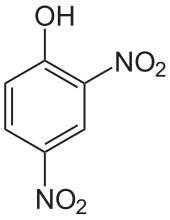Nitrophenol

p-Nitrophenol
Nitrophenols are compounds of the formula HOC6H5-x(NO2)x. The conjugate bases are called nitrophenolates. Nitrophenols are more acidic than phenol itself.[1]
Mono-nitrophenols
with the formula HOC6H4NO2. Three isomeric nitrophenols exist:
- o-Nitrophenol (2-nitrophenol; OH and NO2 groups are neighboring; CAS number: 88-75-5), a yellow crystalline solid (m.p. 46 °C).
- m-Nitrophenol (3-nitrophenol, CAS number: 554-84-7), a yellow solid (m.p. 97 °C) and precursor to the drug mesalazine (5-aminosalicylic acid).
- p-Nitrophenol (4-nitrophenol, CAS number: 100-02-7), yellow crystals (m.p. 114 °C). It is a precursor to the rice herbicide fluorodifen and the pesticide parathion.
The mononitrated phenols are often hydrogenated to the corresponding aminophenols that are also useful industrially.[1]
Di- and trinitrophenols
2,4-Dinitrophenol (m.p. 83 °C) is a moderately strong acid (pKa = 4.89). 2,4,6-trinitrophenol is better known as picric acid, which has a well-developed chemistry.
Safety
Nitrophenols are poisonous.[2][3] Occasionally, nitrophenols contaminate the soil near former explosives or fabric factories and military plants, and current research is aimed at remediation.
References
- 1 2 Gerald Booth (2007). "Nitro Compounds, Aromatic". Ullmann's Encyclopedia of Industrial Chemistry. Weinheim: Wiley-VCH. doi:10.1002/14356007.a17_411.
- ↑ Nitrophenol
- ↑ Dinitrophenol
External links
This article is issued from
Wikipedia.
The text is licensed under Creative Commons - Attribution - Sharealike.
Additional terms may apply for the media files.
